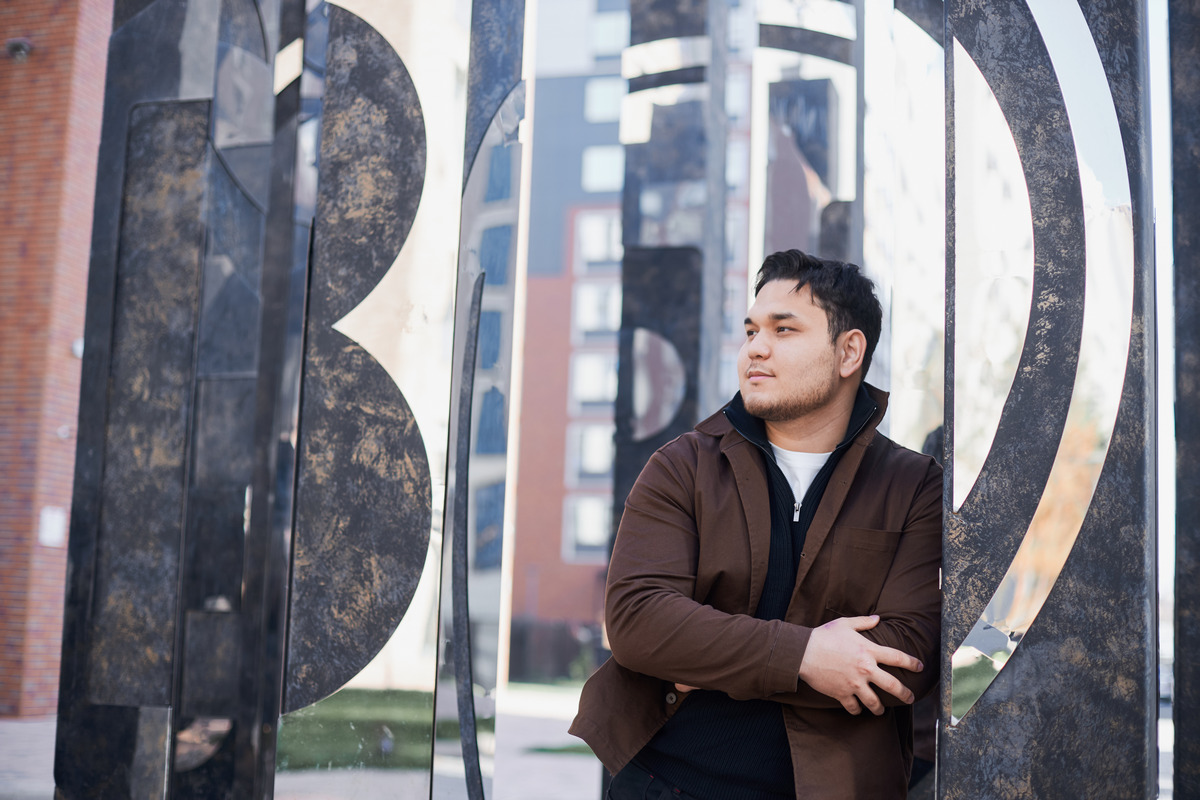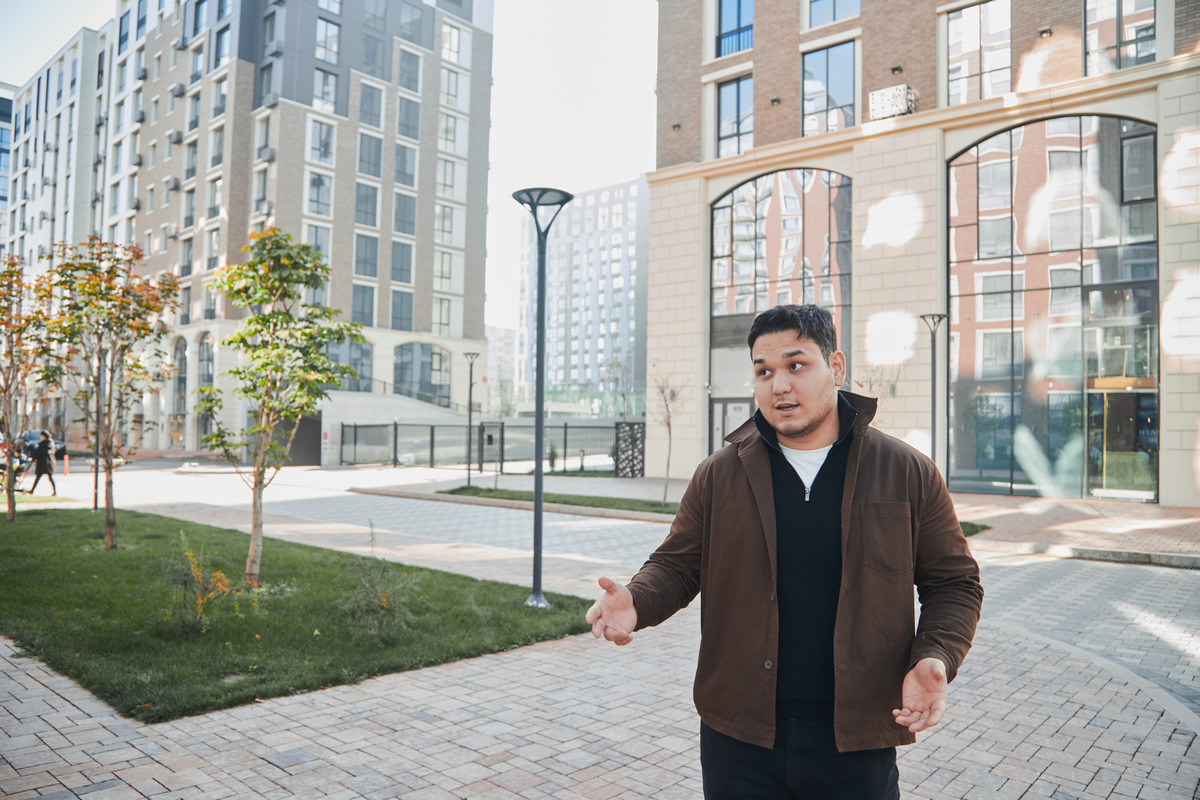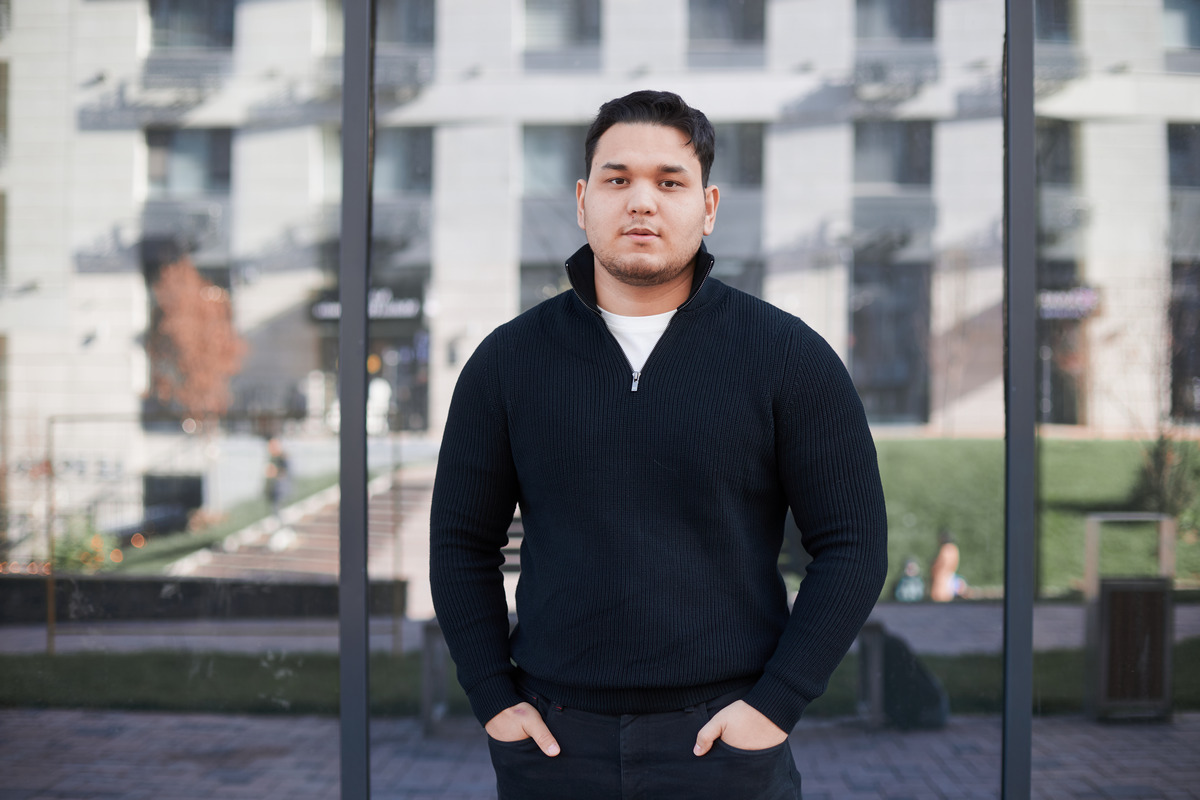It turns out that schools do not require VR
— I am currently a mobile developer and also teach informatics at a private school. Simultaneously, I am involved in the qMeta startup with Rasul Abuov and Aisultan Baktygali, who are my students. Previously, we collaborated on scientific projects at school.
The concept of employing VR technologies surfaced amid the pandemic, a time when virtually everyone was online, with even teachers conducting classes through calls on Microsoft Teams.

My students and I were in the midst of a discussion about potential ventures in this field. We pondered, why not experiment with conducting physics and chemistry classes using VR glasses? It offers a much more engaging experience than a simple video call.
We developed an MVP, showcased it in various startup contests, and aimed to monetize the project. Our initial plan was to sell the product to school directors, but the idea did not succeed.
— What led to the lack of success for the virtual reality idea in education?
— We attempted to approach the higher echelons and engaged in discussions with the ministries. However, integrating VR into the state school structure necessitates a complete overhaul of the education system, including acquiring VR glasses through the procurement system, establishing specialized facilities, and more. As a result, we were advised to initiate the implementation in the private sector.

Private schools expressed interest in the idea, but they preferred to use the product free of charge, which doesn’t align with our interests. Additionally, they harbored doubts about the effectiveness of this educational approach. Even after conducting trial classes with VR glasses, they remained skeptical about the technology. It’s possible that one of the reasons for this skepticism is that school directors are accustomed to traditional education methods and may not be very receptive to innovations.
However, we opted not to give up and persisted in searching for another avenue. By chance, in the changing room after the gym, I conversed with an individual who happened to be the director of a construction company. I briefly outlined my VR idea, and subsequently, we arranged to meet with him along with my entire team to present the project. We reached an agreement to create a virtual tour using VR glasses for the residential complex, and we prepared the MVP.
The building is not yet constructed, but you can still access the apartment
— What functionalities are available in qMeta at present?
— Our portfolio now includes successfully implemented cases with residential complexes for construction companies in Aktau. The developed models enable virtual walks throughout the area, entry into the lobby and elevator, navigation to the desired floor, exploration of apartments with completed repairs and furnished interiors, and even viewing the scenery from the windows. The experience closely mirrors real-life scenarios when navigating the residential complex using VR glasses. In essence, we’ve crafted an environment where potential buyers can hardly distinguish computer-generated imagery from reality.
Another technology involves 3D tours displayed on large sensor screens without the need for VR glasses. On these screens, you can explore a three-dimensional model of the residential complex from all angles, observe the floor and apartment zoning. The integrated CRM system provides visual cues indicating apartments that are already sold, booked, and those available for purchase.

In essence, we enable individuals to experience being inside an apartment that doesn’t exist in reality yet. Typically, construction companies initiate sales during the excavation stage, well before actual construction commences. In sales offices, they can only present pictures, plans, and, at most, some renders. So, how can people make informed purchase decisions today?
Through virtual reality, an individual can virtually touch their future apartment: stroll inside, strategize for repairs, and arrange furniture placement. This expedites the decision-making process for potential buyers.
It indeed operates in this manner. For instance, based on international experience, sales in residential complexes incorporating virtual reality nearly double at the initial stage. One out of every three clients who visits the construction company’s sales office and experiences the 3D glasses ends up purchasing an apartment. Our involvement with residential complexes like Orda Palace and Samal Avenue validates this observation: clients spend more time at the sales office, pose additional questions, and exhibit increased engagement, partly due to the wow effect – this is the feedback we receive from our partners.
Recently, I was in the process of searching for an apartment in Almaty. The options presented by construction companies only included 2D plans on paper and explanations in basic terms, with the building itself still under construction. This left me dissatisfied, prompting me to opt for the secondary housing market. However, had I been offered the opportunity to explore my prospective new apartment, I would have at least considered the purchase. It would have left me with positive impressions about the construction company embracing modern technologies.
— What is the process for generating virtual 3D tours?
— The construction company supplies all the input data based on our checklist, including architectural drawings, dimensions, front sections, plans, building elevations, and descriptions of textures and materials, among other details.
We assess and discuss all the provided information with our 3D engineers and programmers to determine the development timeline. Subsequently, we present a commercial offer to the construction company. If the agreement is reached, we capture a 360-degree video from a drone. Using the drawings, we then create a comprehensive model of the residential complex on game engines, integrating CRM and other elements. The end result is a model that accurately reflects real sizes and plans.
Engineering akin to that of Tony Stark
— What is the timeframe for developing the model of the residential complex?
— We recently engaged in negotiations regarding the digital imaging of a residential complex comprising 15 buildings. Our estimation indicates that the work on the first nine buildings will require a timeframe of 4 to 5 months. For a smaller complex, the projected duration is expected to be between 3 to 4 months.
However, the duration is contingent on factors such as the number of plans, building fronts, and even the location. For instance, if the project is intended for Almaty and there’s a need to showcase the 3D representation of the surrounding mountains, nearby parks, trade centers, and other infrastructure, this would necessitate a more extended time period.
—Which of your processes are automated? In the scenario where a multitude of construction companies approach you simultaneously, forming a queue lasting for 10 years would be impractical.
— In terms of logic, our processes are entirely automated. We don’t create anything from the ground up for a particular project; instead, we utilize existing logics and engines. However, the development of individual models requires human involvement and cannot be accomplished without it.

It is feasible to incorporate residential complexes into the existing models of Almaty. Today, new tools are constantly emerging, and we actively monitor and implement them in our work.
The automation challenge is inherently complex. We strive to automate all facets of our processes and aspire to increase automation in the future. However, it’s worth noting that current technologies have not yet reached the level of sophistication seen in the holographic engineering system utilized by Tony Stark.
If a tool emerges, such as one for accurate and swift modeling of small parts, we will undoubtedly incorporate it into our workflow.
— Do you have an interest in B2C? For instance, you could develop 3D tours for apartment owners looking to sell their properties.
— Not particularly. Currently, we create models for things that don’t exist yet, offering the chance to visualize oneself in a virtual apartment before making a purchase. When it comes to existing apartments, there’s no need for imagination as they already exist. Taking pictures is sufficient for these cases. Such modeling is costly and not financially viable.
— Can construction companies afford to create such tours, especially considering the costs exceeding $15 thousand?
— It may not be economically viable to deploy such technology in mid-level residential complexes. Our modeling services are in higher demand by companies targeting the premium segment, where the value of our product can be offset even by the sale of a single apartment.

Compared to 2021-22, when apartment purchases were widespread, the competition for clients is notably more intense today. Companies now need to distinguish themselves further, and one option is the incorporation of modern technologies.
— Do you have competitors?
— There is a company in Kazakhstan, Singularity Lab, specializing in virtual and augmented reality developments. However, they utilize outsourcing, handling everything on demand, ranging from mobile applications to game development. Similarly, a sizable company in Russia employs the same technologies as we do, but their prices are 5-6 times higher due to their scale.
Certain construction companies attempt to implement VR independently, but the quality is often subpar. In such cases, the buildings may resemble simple bricks from Minecraft, lacking detailed shades, effects, and proper lighting.
Working without making a profit to demonstrate effectiveness
— Provide an overview of the startup’s economic landscape. What was the initial investment in the project, and is it cost-effective today?
— We are in the initial stage, which is why we haven’t attracted investments. We used our own funds to buy computers, spending approximately one million tenge to fulfill the first order without prepayment.
The startup has been operating as a commercial project for around six months, during which we successfully executed two projects. These projects were not profitable, as we deliberately excluded our profit margins. Our strategy involves implementing additional projects by the end of the year to enhance our portfolio, gather compelling case studies, and demonstrate the effectiveness of our product to construction companies. Subsequently, we intend to seek investors for further development. This explains our current lower pricing strategy.
—What are the opinions of companies regarding new technologies?
— We initiated our project in Aktau, and only two out of ten companies showed interest. There is significant skepticism about VR glasses among many, primarily due to concerns about explaining the technology to elderly customers.
But we persist and continue to move forward despite any obstacles. We conduct additional presentations, enhance the product and communication, all in an effort to demonstrate our effectiveness.
Over the next one or two years, our goal is to fully capture the market in Kazakhstan, particularly focusing on large companies engaged in the construction of premium-class buildings. With approximately 20-25 such construction companies in the market, we have already reached out to several, and it’s evident that some are receptive to adopting new technologies and embracing innovative experiences.
— Are you seeking investments, and if so, what specific purposes would the funds serve?
— Yes, we do. Primarily, we require investments to accelerate growth. Currently, we deliberately avoid working with large volumes to assess our capabilities. However, if, for example, we have 5-6 orders simultaneously, we will need an office, as we currently work remotely from our homes. In the future, opening an office will require hiring more employees and identifying young and promising individuals. We have already observed that game development in Kazakhstan is at a relatively poor stage compared to Russia and other foreign countries. Currently, we hire developers from Russia, but our future aim is to recruit local talent and train them from the ground up.

Moreover, we are exploring innovative concepts in entirely different domains. Currently, we are in the process of developing a product for car dealerships involving VR and 3D technology. This endeavor also necessitates additional investments.
The motivation is to reach the summit
— How about expanding to other countries?
— In the next year or two, our focus is on the Kazakhstan market. Although our understanding of other countries is somewhat vague at the moment, we do plan to extend beyond Kazakhstan, targeting regions like the UAE and Georgia. In these areas, residential complexes are being constructed extensively, fostering strong competition among construction companies. This indicates a demand for new technologies, and we believe our competitive advantage in terms of price and quality will be more pronounced.
— Will your base of operations be in Kazakhstan?
—It depends on the volume. If we receive numerous orders, opening a local office becomes necessary. However, if the volume is minimal, we can handle everything within Kazakhstan and dispatch employees on business trips for negotiations, location inspections, and capturing shots.
— What is your vision for the long-term future of your startup?
— This is a philosophical question at the moment, given that everything is subject to change. What I say today may evolve, and within six months, we might embark on a completely different development trajectory.

My team and I are intrigued by the potential heights we can attain. With no limitations, our goals encompass becoming a prominent corporation, establishing a renowned brand, and catering to a global audience.
Certainly, financial motivation is a factor, but we also aspire to distinguish ourselves and accomplish significant endeavors, including the implementation of social projects. Our journey began with the desire to enhance education through VR technologies, and we remain motivated to contribute meaningfully to society.
Like many startups today, we face challenges and make sacrifices in terms of time, sleep, and finances. However, a shared objective unites us: to ensure the success of our product and achieve something noteworthy.

It turns out that schools do not require VR
— I am currently a mobile developer and also teach informatics at a private school. Simultaneously, I am involved in the qMeta startup with Rasul Abuov and Aisultan Baktygali, who are my students. Previously, we collaborated on scientific projects at school.
The concept of employing VR technologies surfaced amid the pandemic, a time when virtually everyone was online, with even teachers conducting classes through calls on Microsoft Teams.

My students and I were in the midst of a discussion about potential ventures in this field. We pondered, why not experiment with conducting physics and chemistry classes using VR glasses? It offers a much more engaging experience than a simple video call.
We developed an MVP, showcased it in various startup contests, and aimed to monetize the project. Our initial plan was to sell the product to school directors, but the idea did not succeed.
— What led to the lack of success for the virtual reality idea in education?
— We attempted to approach the higher echelons and engaged in discussions with the ministries. However, integrating VR into the state school structure necessitates a complete overhaul of the education system, including acquiring VR glasses through the procurement system, establishing specialized facilities, and more. As a result, we were advised to initiate the implementation in the private sector.

Private schools expressed interest in the idea, but they preferred to use the product free of charge, which doesn’t align with our interests. Additionally, they harbored doubts about the effectiveness of this educational approach. Even after conducting trial classes with VR glasses, they remained skeptical about the technology. It’s possible that one of the reasons for this skepticism is that school directors are accustomed to traditional education methods and may not be very receptive to innovations.
However, we opted not to give up and persisted in searching for another avenue. By chance, in the changing room after the gym, I conversed with an individual who happened to be the director of a construction company. I briefly outlined my VR idea, and subsequently, we arranged to meet with him along with my entire team to present the project. We reached an agreement to create a virtual tour using VR glasses for the residential complex, and we prepared the MVP.
The building is not yet constructed, but you can still access the apartment
— What functionalities are available in qMeta at present?
— Our portfolio now includes successfully implemented cases with residential complexes for construction companies in Aktau. The developed models enable virtual walks throughout the area, entry into the lobby and elevator, navigation to the desired floor, exploration of apartments with completed repairs and furnished interiors, and even viewing the scenery from the windows. The experience closely mirrors real-life scenarios when navigating the residential complex using VR glasses. In essence, we’ve crafted an environment where potential buyers can hardly distinguish computer-generated imagery from reality.
Another technology involves 3D tours displayed on large sensor screens without the need for VR glasses. On these screens, you can explore a three-dimensional model of the residential complex from all angles, observe the floor and apartment zoning. The integrated CRM system provides visual cues indicating apartments that are already sold, booked, and those available for purchase.

In essence, we enable individuals to experience being inside an apartment that doesn’t exist in reality yet. Typically, construction companies initiate sales during the excavation stage, well before actual construction commences. In sales offices, they can only present pictures, plans, and, at most, some renders. So, how can people make informed purchase decisions today?
Through virtual reality, an individual can virtually touch their future apartment: stroll inside, strategize for repairs, and arrange furniture placement. This expedites the decision-making process for potential buyers.
It indeed operates in this manner. For instance, based on international experience, sales in residential complexes incorporating virtual reality nearly double at the initial stage. One out of every three clients who visits the construction company’s sales office and experiences the 3D glasses ends up purchasing an apartment. Our involvement with residential complexes like Orda Palace and Samal Avenue validates this observation: clients spend more time at the sales office, pose additional questions, and exhibit increased engagement, partly due to the wow effect – this is the feedback we receive from our partners.
Recently, I was in the process of searching for an apartment in Almaty. The options presented by construction companies only included 2D plans on paper and explanations in basic terms, with the building itself still under construction. This left me dissatisfied, prompting me to opt for the secondary housing market. However, had I been offered the opportunity to explore my prospective new apartment, I would have at least considered the purchase. It would have left me with positive impressions about the construction company embracing modern technologies.
— What is the process for generating virtual 3D tours?
— The construction company supplies all the input data based on our checklist, including architectural drawings, dimensions, front sections, plans, building elevations, and descriptions of textures and materials, among other details.
We assess and discuss all the provided information with our 3D engineers and programmers to determine the development timeline. Subsequently, we present a commercial offer to the construction company. If the agreement is reached, we capture a 360-degree video from a drone. Using the drawings, we then create a comprehensive model of the residential complex on game engines, integrating CRM and other elements. The end result is a model that accurately reflects real sizes and plans.
Engineering akin to that of Tony Stark
— What is the timeframe for developing the model of the residential complex?
— We recently engaged in negotiations regarding the digital imaging of a residential complex comprising 15 buildings. Our estimation indicates that the work on the first nine buildings will require a timeframe of 4 to 5 months. For a smaller complex, the projected duration is expected to be between 3 to 4 months.
However, the duration is contingent on factors such as the number of plans, building fronts, and even the location. For instance, if the project is intended for Almaty and there’s a need to showcase the 3D representation of the surrounding mountains, nearby parks, trade centers, and other infrastructure, this would necessitate a more extended time period.
—Which of your processes are automated? In the scenario where a multitude of construction companies approach you simultaneously, forming a queue lasting for 10 years would be impractical.
— In terms of logic, our processes are entirely automated. We don’t create anything from the ground up for a particular project; instead, we utilize existing logics and engines. However, the development of individual models requires human involvement and cannot be accomplished without it.

It is feasible to incorporate residential complexes into the existing models of Almaty. Today, new tools are constantly emerging, and we actively monitor and implement them in our work.
The automation challenge is inherently complex. We strive to automate all facets of our processes and aspire to increase automation in the future. However, it’s worth noting that current technologies have not yet reached the level of sophistication seen in the holographic engineering system utilized by Tony Stark.
If a tool emerges, such as one for accurate and swift modeling of small parts, we will undoubtedly incorporate it into our workflow.
— Do you have an interest in B2C? For instance, you could develop 3D tours for apartment owners looking to sell their properties.
— Not particularly. Currently, we create models for things that don’t exist yet, offering the chance to visualize oneself in a virtual apartment before making a purchase. When it comes to existing apartments, there’s no need for imagination as they already exist. Taking pictures is sufficient for these cases. Such modeling is costly and not financially viable.
— Can construction companies afford to create such tours, especially considering the costs exceeding $15 thousand?
— It may not be economically viable to deploy such technology in mid-level residential complexes. Our modeling services are in higher demand by companies targeting the premium segment, where the value of our product can be offset even by the sale of a single apartment.

Compared to 2021-22, when apartment purchases were widespread, the competition for clients is notably more intense today. Companies now need to distinguish themselves further, and one option is the incorporation of modern technologies.
— Do you have competitors?
— There is a company in Kazakhstan, Singularity Lab, specializing in virtual and augmented reality developments. However, they utilize outsourcing, handling everything on demand, ranging from mobile applications to game development. Similarly, a sizable company in Russia employs the same technologies as we do, but their prices are 5-6 times higher due to their scale.
Certain construction companies attempt to implement VR independently, but the quality is often subpar. In such cases, the buildings may resemble simple bricks from Minecraft, lacking detailed shades, effects, and proper lighting.
Working without making a profit to demonstrate effectiveness
— Provide an overview of the startup’s economic landscape. What was the initial investment in the project, and is it cost-effective today?
— We are in the initial stage, which is why we haven’t attracted investments. We used our own funds to buy computers, spending approximately one million tenge to fulfill the first order without prepayment.
The startup has been operating as a commercial project for around six months, during which we successfully executed two projects. These projects were not profitable, as we deliberately excluded our profit margins. Our strategy involves implementing additional projects by the end of the year to enhance our portfolio, gather compelling case studies, and demonstrate the effectiveness of our product to construction companies. Subsequently, we intend to seek investors for further development. This explains our current lower pricing strategy.
—What are the opinions of companies regarding new technologies?
— We initiated our project in Aktau, and only two out of ten companies showed interest. There is significant skepticism about VR glasses among many, primarily due to concerns about explaining the technology to elderly customers.
But we persist and continue to move forward despite any obstacles. We conduct additional presentations, enhance the product and communication, all in an effort to demonstrate our effectiveness.
Over the next one or two years, our goal is to fully capture the market in Kazakhstan, particularly focusing on large companies engaged in the construction of premium-class buildings. With approximately 20-25 such construction companies in the market, we have already reached out to several, and it’s evident that some are receptive to adopting new technologies and embracing innovative experiences.
— Are you seeking investments, and if so, what specific purposes would the funds serve?
— Yes, we do. Primarily, we require investments to accelerate growth. Currently, we deliberately avoid working with large volumes to assess our capabilities. However, if, for example, we have 5-6 orders simultaneously, we will need an office, as we currently work remotely from our homes. In the future, opening an office will require hiring more employees and identifying young and promising individuals. We have already observed that game development in Kazakhstan is at a relatively poor stage compared to Russia and other foreign countries. Currently, we hire developers from Russia, but our future aim is to recruit local talent and train them from the ground up.

Moreover, we are exploring innovative concepts in entirely different domains. Currently, we are in the process of developing a product for car dealerships involving VR and 3D technology. This endeavor also necessitates additional investments.
The motivation is to reach the summit
— How about expanding to other countries?
— In the next year or two, our focus is on the Kazakhstan market. Although our understanding of other countries is somewhat vague at the moment, we do plan to extend beyond Kazakhstan, targeting regions like the UAE and Georgia. In these areas, residential complexes are being constructed extensively, fostering strong competition among construction companies. This indicates a demand for new technologies, and we believe our competitive advantage in terms of price and quality will be more pronounced.
— Will your base of operations be in Kazakhstan?
—It depends on the volume. If we receive numerous orders, opening a local office becomes necessary. However, if the volume is minimal, we can handle everything within Kazakhstan and dispatch employees on business trips for negotiations, location inspections, and capturing shots.
— What is your vision for the long-term future of your startup?
— This is a philosophical question at the moment, given that everything is subject to change. What I say today may evolve, and within six months, we might embark on a completely different development trajectory.

My team and I are intrigued by the potential heights we can attain. With no limitations, our goals encompass becoming a prominent corporation, establishing a renowned brand, and catering to a global audience.
Certainly, financial motivation is a factor, but we also aspire to distinguish ourselves and accomplish significant endeavors, including the implementation of social projects. Our journey began with the desire to enhance education through VR technologies, and we remain motivated to contribute meaningfully to society.
Like many startups today, we face challenges and make sacrifices in terms of time, sleep, and finances. However, a shared objective unites us: to ensure the success of our product and achieve something noteworthy.






